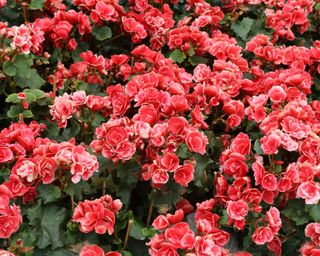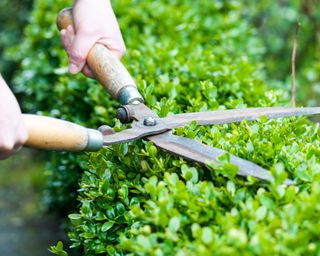

Get ready for the warmer months and learn what to prune in summer to keep flowers, bushes, and trees happy and healthy.
Before you start making any drastic cuts, we've asked gardening and landscaping experts what to trim back during this period. They advise how can keep your plants looking full and lush, and only pruning what is necessary to help them thrive.
Once you start planning your gardening jobs for the year, your green space will flourish, and florals will produce more stunning blooms than ever.
What to prune in summer
After nailing your garden plant ideas, you need to make sure you're looking after your blooms all year long so they don't wilt or die off. Pruning, or selectively cutting off parts of a plant, will actually keep your plants and flowers healthy throughout the seasons. Think of it like a gardening haircut!
But exactly do you need to trim? If you're a newbie to the gardening game, you may be a little worried about cutting off all your precious sprouts especially when it's hotter. Don't worry — our pros are here to the rescue to explain what to prune in summer.
"I’ve seen the impact of proper summer pruning on plant health and aesthetics. During the summer months, it’s essential to focus on deadheading flowering shrubs, thinning fruit trees, and maintaining hedges and topiaries," says Joe Gerrior, owner of Gerrior Masonry & Landscape Construction Corp.
Wondering how to actually prune your plants? Josh Tesolin, co-founder of RusticWise, a resource for home, garden, and sustainability says, "The best way to keep these types of plants tidy and healthy is to pinch them back. You can do this with your fingers by simply pinching and pulling off the top inch or two of the tips or you can also use a pair of sharp hand pruners to do this."

Price: $20.43
These stainless steel pruning shears from Amazon's own range are just the right size for smaller jobs like flowering plants and thin branches. They come with a non-slip TPR handle which ensures precision and safety when trimming.

Price: $29.99
These heavy-duty hedge shears are good for bigger jobs such as tackling unruly shrubs and bushes. These shears come equipped with a shock absorber to reduce arm and shoulder fatigue while pruning.

Price: $53.95
For serious pruning, use an electric trimmer like this one from Greenworks to conquer all kinds of hedges. It's powered by a four amp electric motor and has a 22 inch dual-action steel blade for precise trimming.
1. Flowering plants

Trimming flowering plants are a good place to start when it comes to summer pruning as the petals and flower heads can dry out quickly and weigh down the plant.
"Deadheading spent flowers from plants keeps the energy production on growing lush new flowers and foliage instead of seed production," says Josh.
But which types of flowers should you be trimming?
"Think flowering annual plants such as begonia, celosia, coleus, and petunia—especially if they are experiencing leggy growth. Other perennial plants that get top-heavy could do with a small pruning to make the plant fuller and healthier. These include chrysanthemum, sedum, and sneezeweed," says Josh.
Plus, flowering plants can help attract wildlife to your yard. "Flowers like bee balm, yarrow, and phlox, which are all summer perennials, should be pruned during the late spring-early summer period. Pruning these plants helps ensure that they are as abundant with healthy flowers as possible during the summer. These are also the kind of plants that can be really helpful with attracting pollinators to your yard," says Jeremy Yamaguchi, CEO of Lawn Love.
Removing flowers now will actually help more bloom next year for an even bigger garden. "I always make sure to remove spent blooms just above a healthy set of leaves. This not only keeps the plants looking tidy but also encourages a second wave of flowers. In our projects, this simple practice has significantly extended the blooming season," says Scott McLeod, owner of McLeod Landscaping.
2. Fruit trees

Do you have fruit trees like lemons or apples in your yard? Whether you have potted trees, like this lemon brush from Walmart, or wild ones, it's time to give them a trim. "By carefully removing crowded branches, you can improve air circulation and sunlight reach, which helps prevent diseases. On several of our clients’ properties, we’ve seen a notable improvement in fruit quality and harvest ease. I always ensure not to remove more than 20-30% of the canopy at once to minimize stress on the trees," says Scott.
Cutting back the branches on a fruit tree not only helps the amount of fruit a tree will produce but will improve the taste as well. "By prudently eliminating some excess branches as well as any suckers or water sprouts, more air will be able to flow through the tree and sun rays directly penetrate into it, leading to the development of juicy larger fruits during summer. Furthermore, thinning out the crown makes the energy of the plant evenly distributed hence a lot of fruits that can be harvested," says Nathan Thorne, a professional gardening expert and CEO of Handyflowers.
3. Hedges and shrubs

If you've planted some shrubs for privacy in your yard, they will need tidying for the summer months. Just make sure to sharpen your garden shears (we love these best-selling Fiskars shears from Walmart) before you get started.
Nicely trimmed hedges are a great landscaping idea for small backyards. "Hedges are the silent heroes of landscaping since they provide privacy, structure, and a sense of enclosure to outdoor spaces. To maintain their neat appearance throughout summer periods, I suggest you prune them in late spring or early summer. It’s important not to over-prune while using sharp shears or hedge trimmers to take on your desired shape," says Nathan.
Or you can use an electric trimmer, like this Black + Decker hedge trimmer available on Amazon with over 13,000 reviews. "I use electric trimmers for precision, making sure to keep the top slightly narrower than the base to allow sunlight to reach all parts of the plant. This technique has consistently resulted in lush, green growth for our clients," says Scott.
Gardening with the season is an important part of keeping a healthy, beautiful garden. Trimming back flowering plants, trees, and hedges, will not only create a neat and tidy backyard but ensure they grow back even stronger next year. If you're looking to add more blooms to your green space, you may want to check which gardening zone you're in to make sure your plants will thrive in the climate.
Join our newsletter
Get the best home decor ideas, DIY advice and project inspiration straight to your inbox!

Hey! I’m Emily and I’m the deputy digital editor at Real Homes. I’m here to bring you the latest decor trends, inspirational ideas, informative how tos, the latest celeb homes style and the best budget-friendly buys. I live in a rented apartment, making the most of small spaces and using accent pieces to make things pop. When I’m not writing, I’m usually doing yoga, eating chocolate or working on my skincare routine.